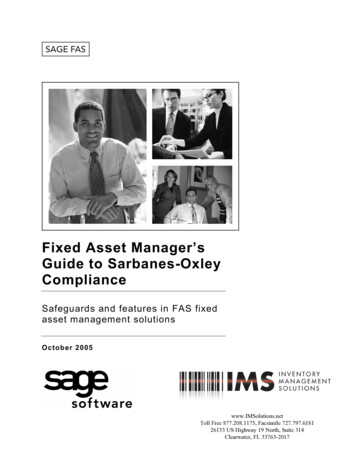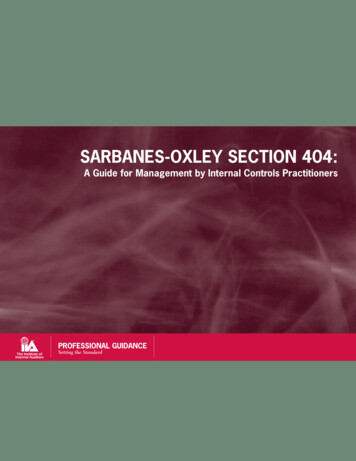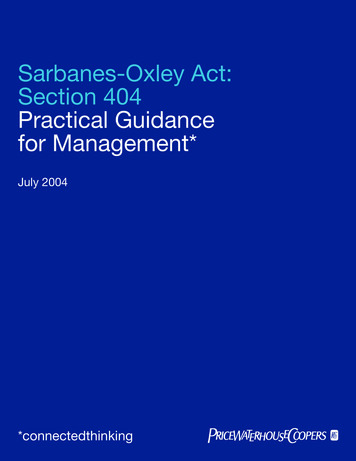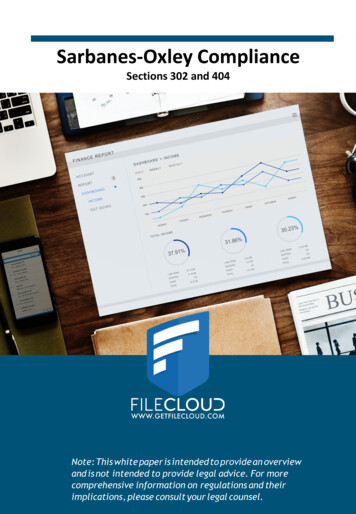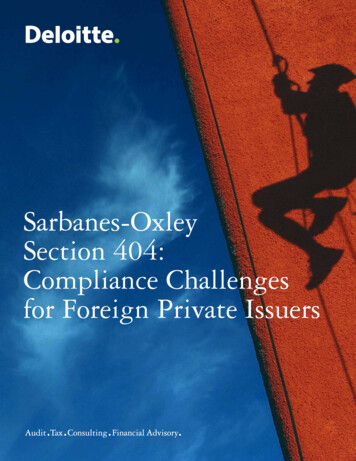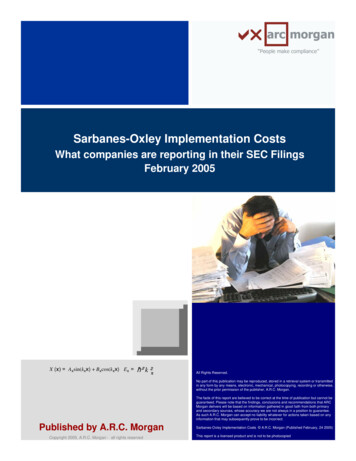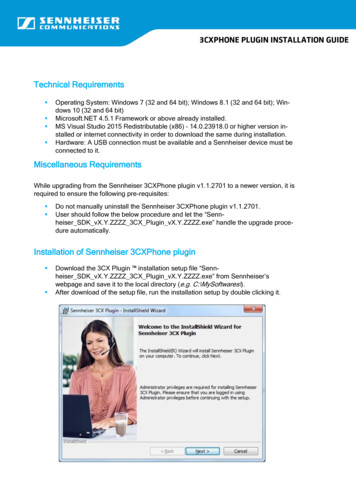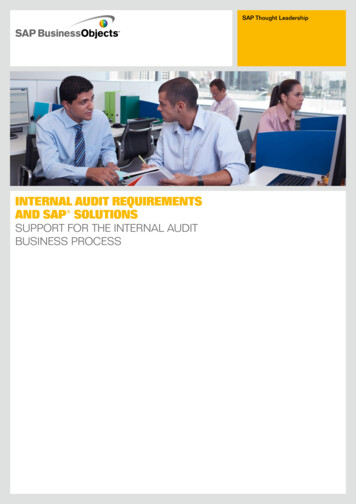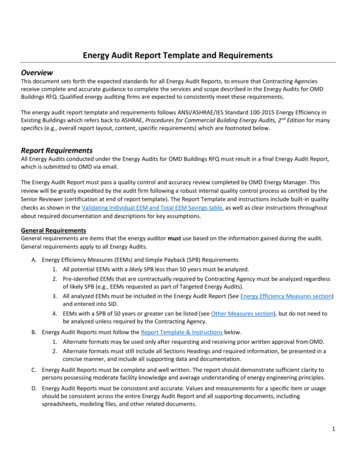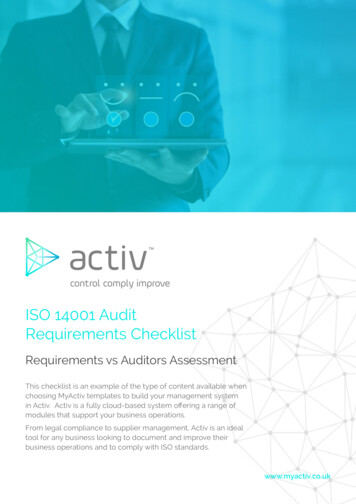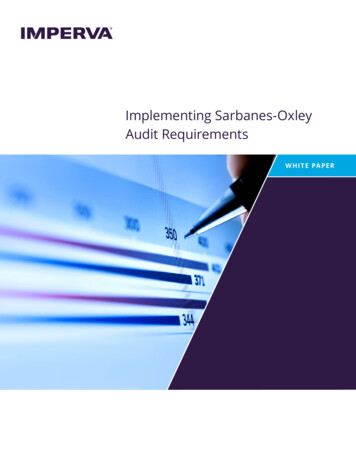
Transcription
Implementing Sarbanes-OxleyAudit RequirementsW H I T E PA PE R
Implementing Sarbanes-OxleyAudit RequirementsW H I T E PA PE RThe Sarbanes-Oxley Act (SOX) establishes requirements for the integrity of the source dataused in financial transactions and reporting. In particular, auditors are looking at regulateddata residing in databases connected to enterprise applications such as SAP, OracleE-Business Suite, PeopleSoft, and other Web Applications.To prove the integrity of financial data, companies must extend audit processes to the financialinformation stored within corporate databases. To verify regulatory compliance, auditors lookat multiple aspects of a database environment including: user management, authentication,separation of duties, access control, and audit trail.Auditors and information technology (IT) professionals must work together to prove that datausage in Oracle E-Business Suite, SAP, PeopleSoft and other package or custom applicationsmeets SOX control requirements. Also, database administrator (DBA) and developer activitythat takes place outside the structured business process of these applications must bemonitored against controls.In the following White Paper, we present the range of functions that need to take place toachieve and demonstrate compliance with SOX.Compliance RequirementsThe Sarbanes Oxley Act (SOX) and its variants around the world (SOX and others) wereenacted as a result of high profile accounting scandals surrounding Enron, MCI WorldComand other public companies.SOX has put stringent regulations on the corporate governance of publicly traded companiesto ensure the protection and validation of all financial data. As information systems automatemore areas of the business, the IT component of SOX compliance becomes increasinglyimportant. Two sections of SOX pose particularly significant implementation and compliancechallenges—these are sections 302 and 404. These sections require that the CEO and CFOof an organization certify and assert to stakeholders that the financial statements of thecompany and all supplemental disclosures are truthful and reliable, and that management hastaken appropriate steps and implemented controls to consistently produce reliable financialinformation to its stakeholders (Section 302). The company’s external auditor must report onthe reliability of management’s assessment of internal control (Section 404).In many organizations, every business application like Oracle EBS, SAP, PeopleSoft and thelike, touches financial data stored in databases. IT is chartered not only to set and enforcedata access controls for business systems, but also to show that the controls are followed, andreport any instances of violations.2
Implementing Sarbanes-OxleyAudit RequirementsW H I T E PA PE RImperva Data Securityand Compliance LifecycleA Framework for Successful Standards ComplianceThe major source of anguish and expense during the course of a corporate governanceproject is that SOX is actually meant to be a guideline for the reporting of financial data withreliability and integrity. SOX is pretty nebulous about the business and IT requirements thatneed to be met in order to be considered SOX-compliant. What is particularly frustrating forexecutives and IT alike is that the requirements for compliance can be subject to interpretationand every organization needs to figure out what controls need to be implemented. Often,organizations choose to work with a management framework like COBIT, ISO-17799 orSAS 70, which provide structure and definition to the controls that need to be placed in theorganization. For more specific technical guidelines, organizations use the ‘Database SecurityTechnical Implementation Guide’ (STIG) Developed by the Defense Information SystemsAgency (DISA) for the Department of Defense (DOD) and published to the public domainand/or the Center for Internet Security (CIS) Benchmarks.These frameworks tend to be lengthy, abstract and overwhelming to absorb. Fortunately, thereare a few key, common elements shared by most frameworks. These include the following fourpractices: Assess—Gather risk and data usage information Set Controls and Policies—Define acceptable usage pattern Monitor and Enforce—Capture activity and prevent unauthorized actions Measure—Report on activity, recommend refinements as neededAssessAssessments start with identifying assets included in the scope of the project. Knowing wheredata resides in an organization is the first step for creating effective protection policies, andan essential part of any security project. SecureSphere automatically discovers the locationand usage of all servers in the large disparate network and identifies databases, schemas,and objects which contain sensitive data, mapping out the potential security project.Comprehensive Vulnerability Scans validate configuration settings, identify security bestpractices gaps and point out were mitigation is needed.Asset usage assessment leverages the Imperva SecureSphere Dynamic Profiling technologywhich analyzes the database and associated IT environment and automatically learns whoaccesses or changes sensitive data, and what mechanisms are used to access the data.Manually gathering such information in a complex environment can be very costly andsometimes impossible.3
Implementing Sarbanes-OxleyAudit RequirementsW H I T E PA PE RSet Controls and PoliciesOnce a complete picture of sensitive data location and usage is available, SecureSphereautomates the creation of audit and security controls based on the learned behavior.SecureSphere’s unique Dynamic Profiling technology overcomes the biggest drawbackassociated with security and compliance solutions – manual creation and maintenance of auditcontrols and security policies. Application and database control requires an understanding ofhundreds of thousands of constantly changing variables including URLs, parameters, cookies,queries, commands, and stored procedures. Dynamic Profiling delivers completely automateddata audit and security with no need for manual configuration or tuning. Valid usage changesare incorporated automatically into the profile as well as audit and security policies. Invalidactivity results in alerts and optional blocking of the activity. If desired, administrators canmanually modify the profiles to bridge any differences between actual usage and corporatesecurity policies. Dynamic Profiling enables SecureSphere to begin protecting yourapplications and data immediately.Monitor and EnforceSecureSphere monitors and maintains an audit log of all data access activity related tofinancial data as required by SOX section 404. The detailed audit log supports broadcompliance reporting, and if needed, forensic analysis. The audit log is created andstored independently from the audited database system, ensuring Separation of Duties.SecureSphere can alert on significant changes in a person’s usage of financial data soadministrators can ensure these changes are in line with compliance policies and preventfraudulent activity. SecureSphere optionally can enforce the defined security policies in realtime by blocking all violations of data usage policy. This allows the CEO/CFO to confidentlyattest to the integrity of their financial statements as required by SOX section 302.MeasureSecureSphere includes a comprehensive set of value-added SOX compliance reports thatdemonstrate configuration and usage are within best practice guidelines. Reports cover thewhole range of infrastructure components from the application layer down to the network.Administrators can define custom reports with the necessary level of audit data granularity,and can export them in .PDF or .CSV formats for easy distribution to auditors and executives.This allows the CEO/CFO to easily review the results of this implementation, validate theintegrity of their financial statements and certify to stakeholders that management has takenappropriate steps and implemented controls to consistently produce reliable financialinformation to its stakeholders as require by Sections 302 and 404.4
Implementing Sarbanes-OxleyAudit RequirementsW H I T E PA PE RSatisfying RegulatoryCompliance AuditsWhat are the Key Requirements for Passing Database Audits?The main key questions that IT professionals must answer during a SOX database auditare as follows:1. Is the audit process independent from the database system being audited?2. Does the audit trail establish user accountability?3. Does the audit trail include appropriate detail?4. Does the audit trail identify material variances from baseline activity?The answers to these questions vary depending upon the audit mechanism employed.Unfortunately, many database audit mechanisms were not designed to meet the requirementsof SOX auditors and therefore do not adequately address these questions. In the followingpages, we will examine the strengths and weaknesses of alternative audit mechanisms relativeto these questions.1. Is the Audit Independent?To ensure audit integrity, the entire process must be independent of the database server anddatabase administrators being audited. Since database administrators and servers are bothpart of the system being audited, they should not be put in a position of auditing themselves.A rogue administrator, for example, with access to audit records may easily tamper with thoserecords to cover his tracks. Similarly, a non-administrator may exploit a database vulnerabilityto elevate privileges and tamper with the audit trail. The requirement for independence hasthree immediate implications for the design of the audit system.1. Audit duties should be separate from database administration. Database administratorsmay participate in the audit to help interpret events, but their participation shouldbe controlled.2. Audit data collection should be independent of native database software capabilities.Otherwise, a database administrator or non-administrator may tamper with the nativeaudit trail as described above.3. 3. External audit solutions may provide independence, but it’s important to make surethat it does not rely upon any native database software capabilities. Some externalsolutions query native audit mechanisms to collect audit data. As indicated in item 2above, native audit capabilities are vulnerable to tampering.5
Implementing Sarbanes-OxleyAudit RequirementsW H I T E PA PE RSecureSphere—Independent AuditSecureSphere automatically creates a detailed audit trail for MS-SQL, Oracle, DB2, Sybase andInformix environments. SecureSphere offers several advantages versus native database auditcapabilities including: separation of duties, improved database performance, operationalautomation, unified audit for heterogeneous database environments, and Web applicationuser audit accountability.Separation of DutiesSecureSphere maintains complete audit independence both in terms of administrativeduties and audit data collection. SecureSphere may be managed by audit staff with completeseparation from database administrators. The SecureSphere interface is easily interpreted byauditors with limited database expertise, although role-based administration enables readonly database administrator participation if desired.Network-Based Audit Data CollectionSecureSphere extract detailed audit information from network traffic traveling to and froma database. It operates in stealth mode (no IP address, etc.) and remains completely invisibleto perpetrators. All network activity is tracked and audit records cannot be tampered withregardless of database vulnerability or rogue administrator.Host-Based Audit Data CollectionThe SecureSphere DBA Monitor Security Agent tracks all local database activity on thedatabase server. This includes the database administrator working at the database serverconsole or using ssh (secure shell) or other tool to remotely initiate a user session on thedatabase server. Like the SecureSphere gateway, the SecureSphere agent is independent ofnative audit capabilities. Installed on the database server as a lightweight host agent, it directlyintercepts local activity and forwards a record of that activity to a gateway. Since host-basedactivity records are securely stored on the gateway, they cannot be tampered with regardlessof database vulnerability or rogue administrator. Finally, if the host agent is stopped for anyreason, the gateway immediately issues a high priority alert to appropriate staff.6
Implementing Sarbanes-OxleyAudit RequirementsW H I T E PA PE R2. Who is Accountable?The database audit trail must attribute each audited database transaction to specific users.A SOX compliant audit mechanism must log each change to financial reporting data alongwith the name of the user making the change. However, when users access the databasevia Web applications (such as SAP, Oracle E-Business Suite, or PeopleSoft), native databasesoftware audit logs have no awareness of specific user identities. Therefore, when native auditlogs reveal fraudulent database transactions, there is no link to the responsible user.The problem with auditing Web application access is that the user never directly interacts withthe database. Instead, Web applications apply a mechanism known as ‘‘pooled connections’’to access the database on behalf of the user (Figure 1). Using pooled connections, the Webapplication independently authenticates each user and then aggregates all user traffic withina few database connections identified only by the Web application account name. A uniqueconnection for each user is never established and the database receives no informationregarding the identity of the actual user.JoeUsersauthenticate poolsuser connectionsSamTomNative databaseaudit records allusers as“SAPFinance1”Figure 1. Native databaseaudit capabilities recordapplication names, notactual user names.By avoiding the need to authenticate and open unique connections for each user, t
A SOX compliant audit mechanism must log each change to financial reporting data along with the name of the user making the change. However, when users access the database via Web applications (such as SAP, Oracle E-Business Suite, or PeopleSoft), native database software audit logs have no awareness of specific user identities. Therefore, when native audit logs reveal fraudulent database .
